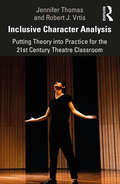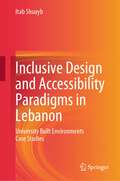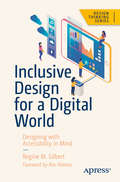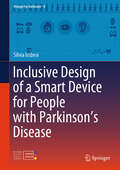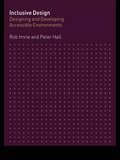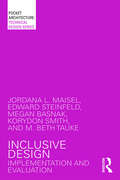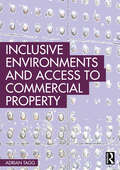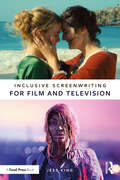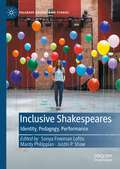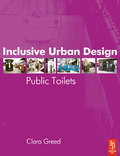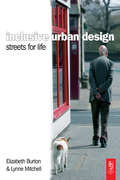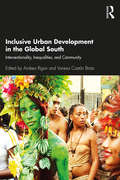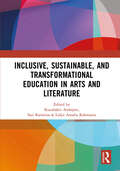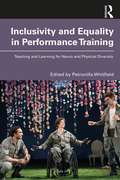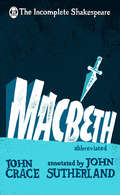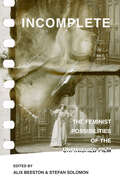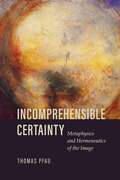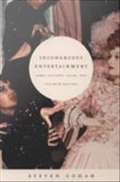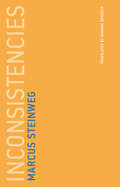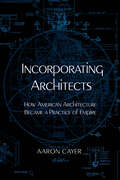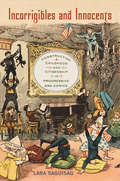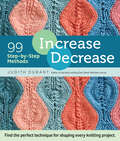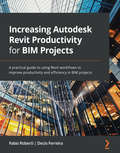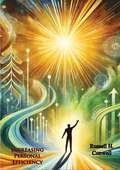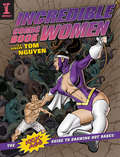- Table View
- List View
Inclusive Character Analysis: Putting Theory into Practice for the 21st Century Theatre Classroom
by Jennifer Thomas Robert J. VrtisInclusive Character Analysis foregrounds representations of race, gender, class, ability, and sexual orientation by blending script analysis with a variety of critical theories in order to create a more inclusive performance practice for the classroom and the stage. This book merges a traditional Stanislavski-based script analysis with multiple theoretical frameworks, such as gender theory, standpoint theory, and critical race theory, to give students in early level theatre courses foundational skills for analyzing a play, while also introducing them to contemporary thought about race, gender, and identity. Inclusive Character Analysis is a valuable resource for beginning acting courses, script analysis courses, the directing classroom, early design curriculum, dramaturgical explorations, the playwriting classroom, and introduction to performance studies classes. Additionally, the book offers a reader-style background on theoretical frames for performance faculty and practitioners who may need assistance to integrate non-performance centered theory into their classrooms.
Inclusive Design and Accessibility Paradigms in Lebanon: University Built Environments Case Studies
by Itab ShuaybThis book describes the disability rights movement that started in the USA and its influence on the disability rights movement in Lebanon, which has led to the endorsement of the Lebanese Disability Act 220/2000. The book introduces the reader to the Lebanese Disability Act 220/ 2000, its definition of disability, and its relation to the medical and social models of disabilities and then articulate the Act articles. Then, it defines the inclusive design paradigm that acknowledges the needs of all people at each stage of their life cycle and presents the difference between inclusive design and accessibility and disability notions. Moreover, the book reviews the different international accessible design standards (American and French) that are adopted in Lebanon with the absence of a nationalized Lebanese design standard and its effect on eliminating barriers and enhancing accessibility at university buildings. Besides, the book presents students' experiences and their satisfaction with the university built environments. 6 university buildings case studies at the American University of Beirut are assessed and analysed to check whether they adopt the inclusive design approach and then propose inclusive design solutions for both heritage and modern university buildings. What makes the book unique is its combination of empirical and theoretical application of inclusive design. The last section, reflects the author’s inclusive design teaching pedagogy. In this section, the author shares samples of students’ class design project and provides recommendations and guidelines for teaching inclusive design so it becomes mainstream.
Inclusive Design for a Digital World: Designing with Accessibility in Mind
by Regine M. GilbertWhat is inclusive design? It is simple. It means that your product has been created with the intention of being accessible to as many different users as possible. For a long time, the concept of accessibility has been limited in terms of only defining physical spaces. However, change is afoot: personal technology now plays a part in the everyday lives of most of us, and thus it is a responsibility for designers of apps, web pages, and more public-facing tech products to make them accessible to all. Our digital era brings progressive ideas and paradigm shifts – but they are only truly progressive if everybody can participate.In Inclusive Design for a Digital World, multiple crucial aspects of technological accessibility are confronted, followed by step-by-step solutions from User Experience Design professor and author Regine Gilbert. Think about every potential user who could be using your product. Could they be visually impaired? Have limited motor skills? Be deaf or hard of hearing? This book addresses a plethora of web accessibility issues that people with disabilities face. Your app might be blocking out an entire sector of the population without you ever intending or realizing it. For example, is your instructional text full of animated words and Emoji icons? This makes it difficult for a user with vision impairment to use an assistive reading device, such as a speech synthesizer, along with your app correctly. In Inclusive Design for a Digital World, Gilbert covers the Web Content Accessibility Guidelines (WCAG) 2.1 requirements, emerging technologies such as VR and AR, best practices for web development, and more.As a creator in the modern digital era, your aim should be to make products that are inclusive of all people. Technology has, overall, increased connection and information equality around the world. To continue its impact, access and usability of such technology must be made a priority, and there is no better place to get started than Inclusive Design for a Digital World.What You’ll LearnThe moral, ethical, and high level legal reasons for accessible designTools and best practices for user research and web developersThe different types of designs for disabilities on various platformsFamiliarize yourself with web compliance guidelinesTest products and usability best practicesUnderstand past innovations and future opportunities for continued improvementWho This Book Is ForPractitioners of product design, product development, content, and design can benefit from this book.
Inclusive Design of a Smart Device for People with Parkinson’s Disease (Design For Inclusion #4)
by Silvia ImbesiThis book reports on an inclusive design project aimed at developing IoT-based wearable devices for special populations. Specifically, it covers the design, the implementation and testing of a smart mHealth system that uses sensory cues to monitor and train the gait and posture of people with Parkinson’s disease. It presents a user-centred strategy to better involve the users in defining the most suitable type of sensory cues and their combination, and in the design of the user interface, at the purpose of developing a gait tutoring system that better fits users’ needs and requirements. All in all, this book offers extensive information on the state-of-the-art in the design and testing of innovative user-centred mHealth systems. Giving a particular attention to the explanation of the tools and methodological choices, it provides readers with a timely reference guide to understand and deal with complex inclusive design projects.
Inclusive Design: Designing and Developing Accessible Environments
by Peter Hall Rob ImrieThe reality of the built environment for disabled people is one of social, physical and attitudinal barriers which prevent their ease of mobility, movement and access. In the United Kingdom, most homes cannot be accessed by wheelchair, while accessible transport is the exception rather than the rule. Pavements are littered with street furniture, while most public and commercial buildings provide few design features to permit disabled people ease of access.Inclusive Design is a documentation of the attitudes, values and practices of property professionals, including developers, surveyors and architects, in responding to the building needs of disabled people. It looks at the way in which pressure for accessible building design is influencing the policies and practices of property companies and professionals, with a primary focus on commercial developments in the UK. The book also provides comments on, and references to, other countries, particularly Sweden, New Zealand, and the USA.
Inclusive Design: Implementation and Evaluation (PocketArchitecture)
by Edward Steinfeld Jordana L. Maisel Korydon Smith Megan Basnak M. Beth TaukeAs part of the PocketArchitecture Series, this volume focuses on inclusive design and its allied fields—ergonomics, accessibility, and participatory design. This book aims for the direct application of inclusive design concepts and technical information into architectural and interior design practices, construction, facilities management, and property development. A central goal is to illustrate the aesthetic, experiential, qualitative, and economic consequences of design decisions and methods. The book is intended to be a ‘first-source’ reference—at the desk or in the field—for design professionals, contractors and builders, developers, and building owners.
Inclusive Environments and Access to Commercial Property
by Adrian TaggThis book presents and examines the challenges and compromises required to deliver inclusivity in the existing commercial-built environment and the socio-economic benefits that could result from successfully delivering it.To illuminate the advantages of an inclusive environment to property owners, investors and service providers, the book covers the history of disability and evolution of the legislation and examines the demographics and types of disability to question the ‘one size’ ‘blanket’ approach that currently exists to providing access. Delving further into the characteristics of the commercial property sectors and individual disability-specific requirements, experienced commercial building surveyor, Adrian Tagg, analyses the contradictions in the existing legislation to establish examples of design compromise or reasonable adjustments. He seeks to contextualise public and commercial attitudes to disability and go further to demystify the term ‘reasonable adjustment’, which is used currently as a tool of compromise in providing access. The aim is to assess disability-specific requirements for access, as well as adopt a simplistic approach to developing access solutions to the existing built environment from a consultancy and user perspective.Ultimately, this publication hopes to promote accessibility and inclusion from the perspective of surveyors, investors and landlords working in commercial property. It is not just targeted at those on undergraduate or post-graduate surveying courses, as well as those early career professionals undertaking their APC or post-graduate qualifications, but also at those owning or delivering goods, services and employment from commercial premises who want to make a difference.
Inclusive Screenwriting for Film and Television
by Jess KingBreaking down the traditional structures of screenplays in an innovative and progressive way, while also investigating the ways in which screenplays have been traditionally told, this book interrogates how screenplays can be written to reflect the diverse life experiences of real people. Author Jess King explores how existing paradigms of screenplays often exclude the very people watching films and TV today. Taking aspects such as characterization, screenplay structure, and world-building, King offers ways to ensure your screenplays are inclusive and allow for every person’s story to be heard. In addition to examples ranging from Sorry to Bother You to Portrait of a Lady on Fire, four case studies on Killing Eve, Sense8, I May Destroy You, and Vida ground the theoretical work in practical application. The book highlights the ways in which screenplays can authentically represent and uplift the lived experiences of those so often left out of the narrative, such as the LGBTQIA+ community, women, and people of color. The book addresses a current demand for more inclusive and progressive representation in film and TV and equips screenwriters with the tools to ensure their screenplays tell authentic stories, offering innovative ways to reimagine current screenwriting practice towards radical equity and inclusion. This is a timely and necessary book that brings the critical lenses of gender studies, queer theory, and critical race studies to bear on the practice of screenwriting, ideal for students of screenwriting, aspiring screenwriters, and industry professionals alike.
Inclusive Shakespeares: Identity, Pedagogy, Performance (Palgrave Shakespeare Studies)
by Sonya Freeman Loftis Mardy Philippian Justin P. ShawInclusive Shakespeares: Identity, Pedagogy, Performance responds to the growing concern to make Shakespeare Studies inclusive of prospective students, teachers, performers, and audiences who have occupied a historically marginalized position in relation to Shakespeare's poetry and plays. This timely collection includes essays by leading and emerging scholarly voices concerned to open interest and participation in Shakespeare to wider appreciation and use. The essays discuss topics ranging from ethically-informed pedagogy to discussions of public partnerships, from accessible theater for people with disabilities to the use of Shakespeare in technical and community colleges. Inclusive Shakespeares contributes to national conversations about the role of literature in the larger project of inclusion, using Shakespeare Studies as the medium to critically examine interactions between personal identity and academia at large.
Inclusive Urban Design: Public Toilets
by Clara GreedThis is a unique text providing both design guidance and policy direction for the provision and design of public toilets covering city-wide, district-level and site-specific principles. It highlights the role of urban design in reversing the trend of inadequate toilet provision, and sets out guidelines for design which meets both user need and provider requirements.Greed presents the fundamental principle that toilets should not be dealt with in isolation from mainstream urban policy, but that they should be seen as a serious core component in both strategic urban policy and local area design. She argues toilets are valuable townscape features in their own right as manifestation civic pride and good urban design - essential architectural components which add to the quality and viability of an area. Although a range of design guidance on toilets exists there is still considerable dissatisfaction with the end product in terms of building design, levels of provision, location, safety, layout, DDA requirements and accessibility. By outlining user demands and provider constraints, Greed shows that it is essential for architects to have an informed understanding and practical knowledge of toilet issues when working with public and private sector providers. Examples of toilet architecture from other countries, and policies from different cultural settings, are included for comparative purposes to invigorate UK perspectives.
Inclusive Urban Design: Streets For Life
by Elizabeth Burton Lynne MitchellThis is the first book to address the design needs of older people in the outdoor environment. It provides information on design principles essential to built environment professionals who want to provide for all users of urban space and who wish to achieve sustainability in their designs. Part one examines the changing experiences of people in the outdoor environment as they age and discusses existing outdoor environments and the aspects and features that help or hinder older people from using and enjoying them. Part two presents the six design principles for ‘streets for life’ and their many individual components. Using photographs and line drawings, a range of design features are presented at all scales of the outdoor environment from street layouts and building form to signs and detail. Part three expands on the concept of ‘streets for life’ as the ultimate goal of inclusive urban design. These are outdoor environments that people are able to confidently understand, navigate and use, regardless of age or circumstance, and represent truly sustainable inclusive communities.
Inclusive Urban Development in the Global South: Intersectionality, Inequalities, and Community
by Andrea RigonInclusive Urban Development in the Global South emphasizes the importance of the neighbourhood in urban development planning, with case studies aimed at transforming current intervention practices towards more inclusive and just means of engagement with individuals and communities. The chapters explore how diversity of gender, class, race and ethnicity, citizenship status, age, ability, and sexuality is taken (or not taken) into account and approached in the planning and implementation of development policy and interventions in poor urban areas. The book employs a practical perspective on the deployment of theoretical critiques of intersectionality and diversity in development practice through case studies examining issues such as water and sanitation planning in Dhaka, indigenous rights to the city in Bolivia, post-colonial planning in Hong Kong, land reform in Zimbabwe, and many more. The book focuses on radical alternatives with the potential to foster urban transformations for planning and development communities working around the world.
Inclusive, Sustainable, and Transformational Education in Arts and Literature: Proceedings of the 7th International Seminar on Language, Education, and Culture, (ISoLEC, 2023), July 07—08, 2023, Malang, Indonesia
by Sari Karmina Kusubakti Andajani Lidya Amalia RahmaniaThis book contains the proceedings of The International Seminar on Language, Education, and Culture (ISoLEC) 2023, an annual conference hosted by the Faculty of Letters, Universitas Negeri Malang. With the theme, Inclusive, Sustainable, and Transformational Education in Arts and Literature, ISoLEC aims to address key issues such as inclusive education in language, arts, and culture, sustainable education in language, arts, and culture, post-pandemic teaching and learning practices, corpus-based language, teaching and research, language in media, gender and identity, pop contemporary and digital culture, culture and spirituality, multilingualism and translanguaging, visual and performing arts, oral tradition and local culture, and digital literacy and information science. This book is a collection of selected articles that were presented at the conference covering issues of arts, language, and cultures. This conference addressed a range of relevant topics including:· Inclusive Education in Language, Arts, & Culture· Sustainable Education in Language, Arts, & Culture· Post Pandemic Teaching and Learning Practices· Corpus-Based Language, Teaching and Research· Language in Media· Gender and Identity· Pop, Contemporary and Digital Culture· Culture and Spirituality· Multilingualism and Translanguaging· Visual and Performing Arts· Oral Tradition & Local Culture· Digital Literacy and Information ScienceThis proceeding will be of interest to students, lecturers, teachers, and academics who are interested in developing their knowledge in the field of language, education, and culture. Specifically, this book will be an interesting read for those who want to reimagine the inclusive and sustainable education.
Inclusivity and Equality in Performance Training: Teaching and Learning for Neuro and Physical Diversity
by Petronilla WhitfieldInclusivity and Equality in Performance Training focuses on neuro and physical difference and dis/ability in the teaching of performance and associated studies. It offers 19 practitioners’ research-based teaching strategies, aimed to enhance equality of opportunity and individual abilities in performance education. Challenging ableist models of teaching, the 16 chapters address the barriers that can undermine those with dis/ability or difference, highlighting how equality of opportunity can increase innovation and enrich the creative work. Key features include: Descriptions of teaching interventions, research, and exploratory practice to identify and support the needs and abilities of the individual with dis/ability or difference Experiences of practitioners working with professional actors with dis/ability or difference, with a dissemination of methods to enable the actors A critical analysis of pedagogy in performance training environments; how neuro and physical diversity are positioned within the cultural contexts and practices Equitable teaching and learning practices for individuals in a variety of areas, such as: dyslexia, dyspraxia, visual or hearing impairment, learning and physical dis/abilities, wheelchair users, aphantasia, attention-deficit/hyperactivity disorder and autistic spectrum. The chapter contents originate from practitioners in the UK, USA and Australia working in actor training conservatoires, drama university courses, youth training groups and professional performance, encompassing a range of specialist fields, such as voice, movement, acting, Shakespeare, digital technology, contemporary live art and creative writing. Inclusivity and Equality in Performance Training is a vital resource for teachers, directors, performers, researchers and students who have an interest in investigatory practice towards developing emancipatory pedagogies within performance education.
Incomplete Shakespeare: Macbeth
by John Sutherland John Crace‘Give me the daggers and I’ll pin the blame/ On Duncan’s grooms who both are also slain. /A little water clears us of this deed /Though a large scotch might also do the trick...’ To celebrate the 400th anniversary of Shakespeare's death, this is the first of a new collection of the Bard's greatest plays, digested to a few thousand words with invaluable side notes from John Sutherland. Funny and incredibly clever, these parodies are a joy for those who know their Shakespeare, perfect for the theatre goer needing a quick recap, and a massive relief for those just desperate to pass their English exam.This ebook has a large amount of footnotes and is best viewed on a device that supports pop-up text.
Incomplete: The Feminist Possibilities of the Unfinished Film (Feminist Media Histories #5)
by Alix Beeston and Stefan SolomonThis field-defining collection establishes unfinished film projects—abandoned, interrupted, lost, or open-ended—as rich and underappreciated resources for feminist film and media studies. In deeply researched and creatively conceived chapters, scholars join with film practitioners in approaching the unfinished film as an ideal site for revealing the lived experiences, practical conditions, and institutional realities of women's film production across historical periods and national borders. Incomplete recovers projects and practices marginalized in film industries and scholarship alike, while also showing how feminist filmmakers have cultivated incompletion as an aesthetic strategy. Objects of loss and of possibility, incomplete films raise profound historiographical and ethical questions about the always unfinished project of film history, film spectatorship, and film studies.
Incomprehensible Certainty: Metaphysics and Hermeneutics of the Image
by Thomas PfauThomas Pfau’s study of images and visual experience is a tour de force linking Platonic metaphysics to modern phenomenology and probing literary, philosophical, and theological accounts of visual experience from Plato to Rilke. <p><p> Incomprehensible Certainty presents a sustained reflection on the nature of images and the phenomenology of visual experience. Taking the “image” (eikōn) as the essential medium of art and literature and as foundational for the intuitive ways in which we make contact with our “lifeworld,” Thomas Pfau draws in equal measure on Platonic metaphysics and modern phenomenology to advance a series of interlocking claims. <p><p>First, Pfau shows that, beginning with Plato’s later dialogues, being and appearance came to be understood as ontologically distinct from (but no longer opposed to) one another. Second, in contrast to the idol that is typically gazed at and visually consumed as an object of desire, this study positions the image as a medium whose intrinsic abundance and excess reveal to us its metaphysical function―namely, as the visible analogue of an invisible, numinous reality. Finally, the interpretations unfolded in this book (from Plato, Plotinus, Pseudo-Dionysius, John Damascene via Bernard of Clairvaux, Bonaventure, Julian of Norwich, and Nicholas of Cusa to modern writers and artists such as Goethe, Ruskin, Turner, Hopkins, Cézanne, and Rilke) affirm the essential complementarity of image and word, visual intuition and hermeneutic practice, in theology, philosophy, and literature. <p><p>Like Pfau’s previous book, Minding the Modern, Incomprehensible Certainty is a major work. With over fifty illustrations, the book will interest students and scholars of philosophy, theology, literature, and art history.
Incongruous Entertainment: Camp, Cultural, and the MGM Musical
by Steven CohanWith their lavish costumes and sets, ebullient song and dance numbers, and iconic movie stars, the musicals that mgm produced in the 1940s seem today to epitomize camp. Yet they were originally made to appeal to broad, mainstream audiences. In this lively, nuanced, and provocative reassessment of the MGM musical, Steven Cohan argues that this seeming incongruity--between the camp value and popular appreciation of these musicals--is not as contradictory as it seems. He demonstrates that the films' extravagance and queerness were deliberate elements and keys to their popular success. In addition to examining the spectatorship of the MGM musical, Cohan investigates the genre's production and marketing, paying particular attention to the studio's employment of a largely gay workforce of artists and craftspeople. He reflects on the role of the female stars--including Judy Garland, Debbie Reynolds, Esther Williams, and Lena Horne--and he explores the complex relationship between Gene Kelley's dancing and his masculine persona. Cohan looks at how, in the decades since the 1950s, the marketing and reception of the mgm musical have negotiated the more publicly recognized camp value attached to the films. He considers the status of Singin' in the Rain as perhaps the first film to be widely embraced as camp; the repackaging of the musicals as nostalgia and camp in the That's Entertainment! series as well as on home video and cable; and the debates about Garland's legendary gay appeal among her fans on the Internet. By establishing camp as central to the genre, Incongruous Entertainment provides a new way of looking at the musical.
Inconsistencies (Untimely Meditations #7)
by Marcus SteinwegMeditations, aphorisms, maxims, notes, and comments construct a philosophy of thought congruent with the inconsistency of our reality. Those who continue to think never return to their point of departure.—Inconsistencies These 130 short texts—aphoristic, interlacing, and sometimes perplexing—target a perennial philosophical problem: Our consciousness and our experience of reality are inconsistent, fragmentary, and unstable; God is dead, and our identity as subjects discordant. How can we establish a new mode of thought that does not cling to new gods or the false security of rationality? Marcus Steinweg, as he did in his earlier book The Terror of Evidence, constructs a philosophical position from fragments, maxims, meditations, and notes, formulating a philosophy of thought that expresses and enacts the inconsistency of our reality. Steinweg considers, among other topics, life as a game (“To think is to play because no thought is firmly grounded”); sexuality (“wasteful, contradictory, and contingent”); desire (”Desire has a thousand names; It's earned none of them”); reality (“overdetermined and excessively complex”); and world (“a nonconcept”). He disposes of philosophy in one sentence (“Philosophy is a continual process of its own redefinition.”) but spends multiple pages on “A Tear in Immanence,” invoking Nietzsche, Heidegger, Sartre, and others. He describes “Wandering with Foucault” (“Thought entails wandering as well as straying into madness”) and brings together Derrida and Debord. He poses a question: “Why should a cat be more mysterious than a dog?” and later answers one: “Beauty is truth because truth is beauty.” By the end, we have accompanied Steinweg on converging trains of thought. “Thinking means continuing to think,” he writes, adding “But thinking can only pose questions by answering others.” The question of inconsistency? Asked and answered, and asked.
Incorporating Architects: How American Architecture Became a Practice of Empire
by Aaron CayerBy the end of the twentieth century, US architecture and engineering firms held more capital than entire countries, employed more people than were housed in most cities, and rented offices in more nations than comprised the UN. Within them, architects were designing not single buildings but urban systems, including the multinational infrastructures, legal codes, and financial mechanisms on which those systems came to depend. However, despite the extraordinary power of these architects, their histories remain shrouded in myth and concealed—by design. This forensic analysis traces a history of architects at one such firm, AECOM, as they assembled their own multinational corporation and embedded themselves in the operations of American empire after World War II, shielding themselves from the instabilities of a postwar political economy. Incorporating Architects reveals how architects, through their businesses more than their drawings or buildings, modulated the political economy, gripped the reins of their profession, and produced the global injustices that define our neoliberal present.
Incorrigibles and Innocents: Constructing Childhood and Citizenship in Progressive Era Comics
by Lara SaguisagHistories and criticism of comics note that comic strips published in the Progressive Era were dynamic spaces in which anxieties about race, ethnicity, class, and gender were expressed, perpetuated, and alleviated. The proliferation of comic strip children—white and nonwhite, middle-class and lower class, male and female—suggests that childhood was a subject that fascinated and preoccupied Americans at the turn of the century. Many of these strips, including R.F. Outcault’s Hogan’s Alley and Buster Brown, Rudolph Dirks’s The Katzenjammer Kids and Winsor McCay’s Little Nemo in Slumberland were headlined by child characters. Yet no major study has explored the significance of these verbal-visual representations of childhood. Incorrigibles and Innocents addresses this gap in scholarship, examining the ways childhood was depicted and theorized in late nineteenth- and early twentieth-century comic strips. Drawing from and building on histories and theories of childhood, comics, and Progressive Era conceptualizations of citizenship and nationhood, Lara Saguisag demonstrates that child characters in comic strips expressed and complicated contemporary notions of who had a right to claim membership in a modernizing, expanding nation.
Increase, Decrease: 99 Step-by-Step Methods; Find the Perfect Technique for Shaping Every Knitting Project
by Judith DurantThe secret to knitting great-fitting hats and shaping elegant sleeves lies in using the right increase or decrease techniques. Approachable and insightful, Judith Durant provides clear instructions and step-by-step photographs that showcase swatches for each technique. From working shaped lace to adjusting necklines, you’ll soon have a go-to strategy for successfully tackling knitting challenges of all shapes and sizes.
Increasing Autodesk Revit Productivity for BIM Projects: A practical guide to using Revit workflows to improve productivity and efficiency in BIM projects
by Fabio Roberti Decio FerreiraDiscover how to implement Revit best practices along with Dynamo and Power BI to visualize and analyze BIM informationKey FeaturesBoost productivity in Revit and apply multiple workflows to work efficiently on BIM projectsOptimize your daily work in Revit to perform more tasks in less timeTake a hands-on approach to improving your efficiency with useful explanations, which will step-change your productivityBook DescriptionRevit software helps architects, BIM coordinators, and BIM managers to create BIM models and analyze data to improve design and construction. Building Information Modeling (BIM) has promoted a transformation in the engineering and construction industries where information is at the core of a methodology that improves productivity, providing several benefits in comparison to the traditional 2D CAD process. This book takes a hands-on approach to implementing this new methodology effectively. Complete with step-by-step explanations of essential concepts and practical examples, this Revit book begins by explaining the principles of productivity in Revit and data management for BIM projects. You'll get to grips with the primary BIM documentation to start a BIM project, including the contract, Exchange Information Requirements (EIR), and BIM Execution Plan (BEP/BXP). Later, you'll create a Revit template, start a Revit project, and explore the core functionalities of Revit to increase productivity. Once you've built the foundation, you'll learn about Revit plugins and use Dynamo for visual programming and Power BI for analyzing BIM information. By the end of this book, you'll have a solid understanding of Revit as construction and design software, how to increase productivity in Revit, and how to apply multiple workflows in your project to manage BIM.What you will learnExplore the primary BIM documentation to start a BIM projectSet up a Revit project and apply the correct coordinate system to ensure long-term productivityImprove the efficiency of Revit core functionalities that apply to daily activitiesUse visual programming with Dynamo to boost productivity and manage data in BIM projectsImport data from Revit to Power BI and create project dashboards to analyze dataDiscover the different Revit plugins for improved productivity, visualization, and analysisImplement best practices for modeling in RevitWho this book is forThis book is for architects, designers, engineers, modelers, BIM coordinators, and BIM managers interested in learning Autodesk Revit best practices. Increasing Autodesk Revit Productivity for BIM Projects will help you to explore the methodology that combines information management and research for quality inputs when working in Revit.
Increasing Personal Efficiency
by Russell H. ConwellIn "Increasing Personal Efficiency," Russell H. Conwell, the esteemed Baptist minister, lawyer, and founder of Temple University, provides a comprehensive guide to maximizing productivity and achieving personal success. Drawing on his extensive experience and keen insights, Conwell offers practical advice and motivational wisdom to help individuals enhance their efficiency in both their personal and professional lives.Conwell's approach to personal efficiency is holistic, emphasizing the importance of mental, physical, and spiritual well-being. He believes that true efficiency arises from a balanced and well-rounded lifestyle that nurtures all aspects of an individual's character and abilities.Key themes include:Time Management: Conwell offers strategies for effective time management, emphasizing the importance of prioritizing tasks, setting realistic goals, and avoiding procrastination. He provides practical tips on how to organize one's day to maximize productivity and achieve a healthy work-life balance.Goal Setting: The book underscores the importance of setting clear, achievable goals. Conwell encourages readers to define their objectives and create actionable plans to reach them, highlighting the role of persistence and determination in achieving success.Self-Discipline: Conwell discusses the vital role of self-discipline in increasing personal efficiency. He provides techniques for developing and maintaining discipline, including habits of regular practice, focus, and resilience.Physical Health: Recognizing the connection between physical health and efficiency, Conwell advises on maintaining a healthy lifestyle through proper nutrition, regular exercise, and adequate rest. He believes that a strong, healthy body contributes significantly to one's overall efficiency and effectiveness.Mental Attitude: Conwell explores the power of positive thinking and a proactive mindset. He encourages readers to cultivate a positive attitude, embrace challenges, and learn from failures as part of their journey toward personal growth and efficiency.
Incredible Comic Book Women with Tom Nguyen: The Kick-Ass Guide to Drawing Hot Babes!
by Tom NguyenSmokin' chicks at your fingertips! You are holding the ultimate guide to drawing kick-ass comic book babes, from sultry eyes and succulent lips to the killer bodies that go with them. Whether you want to capture the likenesses of girls you know or bring fantasy women to life on paper, this book tells you everything you need to create super-heroines, damsels in distress and other original female characters. Step-by-step instruction for drawing eyes, mouths, hands and more Drawing instruction on hairstyles, clothing, facial expressions, ethnic and age variations and much more Expert tips on working with models and photo references, drawing dynamic poses and pumping up the drama with cool lighting effects Five full-length demonstrations simulate real-life "assignments," from cover art to a complete comic-book page Packed with tons of sexy chicks and sweet tricks for boosting the "babe factor" in your own creations, these pages will rock your drawing world.
